|
Montessori in Layman's Terms
I've noticed that most Montessori Web Sites present a wonderful text book description of the Montessori Method and philosophy. As I started to write one for this page, I decided to take a new approach and write a description in more up to date and layman's terms. Being an academic, I enjoy text book descriptions, yet I have seen them so often misinterpreted, that I am attempting this approach instead.
For those of you who are interested in a more traditional description of the Montessori Philosophy, for your convenience, at the bottom of this page are links to other Montessori web sites' descriptions of the Montessori Method .
Lysa De Thomas-Sheehy Montessori Teacher
Montessorians believe that children are individuals with their own strengths, weaknesses, interests, and learning styles. Since we acknowledge all of these traits in each child, we find it impossible to state that, "Every child needs to be on page 16 on September 5." Instead we believe in working with each child at his or her "cutting edge" or "maximum plane of development". In other words, if a child is in third grade, but is working on a 5th grade level in math, we don't say, "Sorry, I know you are ready to do that, but you are in 3rd grade. This is what we are doing in 3rd grade now". In most children this type of response just fosters anger, boredom, and in many children, "misbehavior". Consequently, if a child is in 3rd grade, but reading on a 1st or 2nd grade level, placing him in a 3rd grade reader will just frustrate and overwhelm him, fostering anger, apathy, low self esteem and "misbehavior". Some people feel that retention or promotion is the answer to these problems, and at times they are. Yet, what do you do if a child is socially and/or physically mature enough to be in a higher grade, yet does not possess the skills for that grade? In this case retention might just increase his/her apathy and low self esteem leading to more problems than low grades in the future . Additionally, what do you do if a child is academically proficient enough to be promoted to the next grade, but is not physically and emotionally mature enough? In certain cases, promotion can place these children in social situations that they are not mature enough to handle, fostering, once again, low self esteem and often poor decision making that in higher grades can be very dangerous. Lastly, what do you do with a child who is on grade level or below in one area, and yet above grade level in another? As you can see promotion and retention, as well as everybody being on the same page at the same time is not the answer. At least not for us.
So what is?
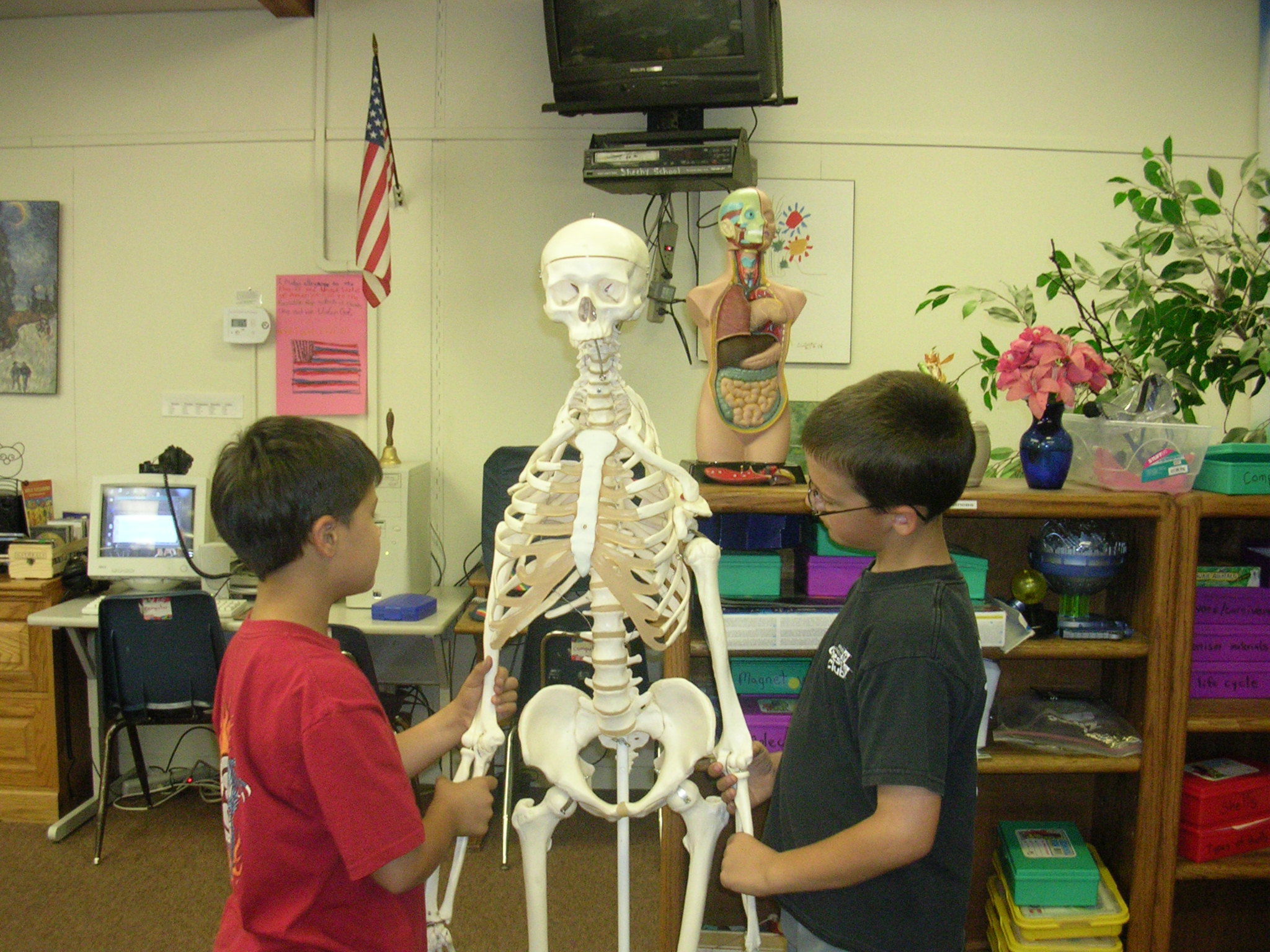
|
| Studying the skeletal system for a report |
| Reading and working together |
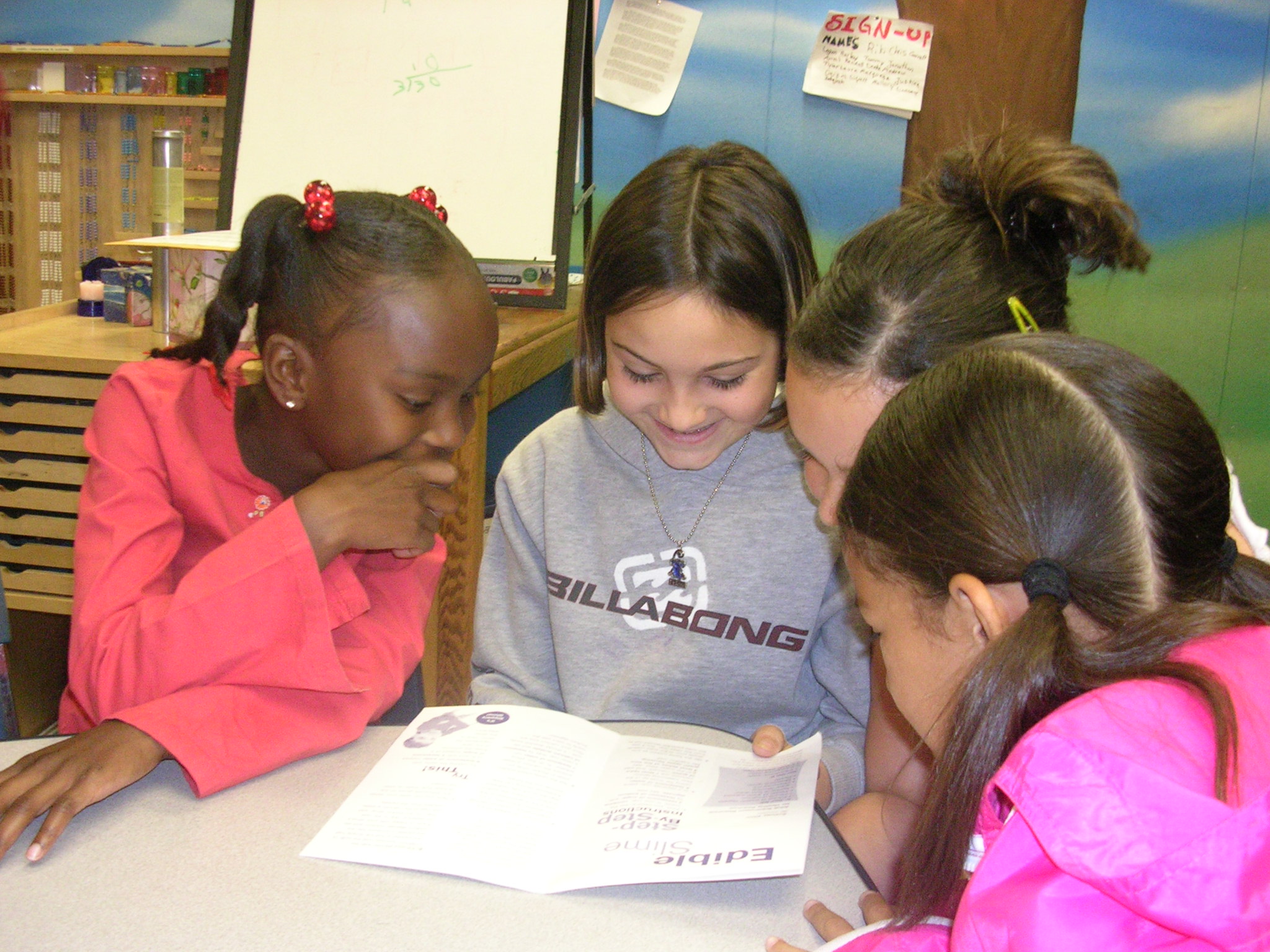
|
Montessorians believe that mixed age groups (3-6 year olds, 6-9 year olds, 9-12 year olds...), flexible groupings (That's where children of equal strength in an area are put together in a group to learn a topic no matter what their age, but the groups are not cut in stone, so that once a child has mastered a concept, he or she may move on to the next, even if the rest of the children in that group have not.), and hands on, multi sensory/multi modality instruction. (This is where concepts are not just taught by rote memorization or out of a text book, but in a variety of ways using color, sound, movement, logic,... to foster reading, writing, and understanding.)
But doesn't every child working on a different activity cause chaos? How does the teacher know that every child is working on his "cutting edge?" How can a teacher control such an "unstructured" classroom?
Nothing gets our ire up as being told that our classrooms are unstructured! Maybe that is because in our minds we connect the words "structured" with "order" and therefore "unstructured" with "disorder". Montessori classrooms, if directed by competent educators, are anything but disorderly. True, there is a lot of different work going on. You won't see neat rows of desks with the same book out and every child sitting quietly doing the same problem. But if a well trained, organized teacher is in charge, you will see a lot of focused, engaging work happening all over the room.
So how can we run a classroom that will fit the needs of all its students without being "disorderly"?
To begin with we believe in a "prepared environment". That is a classroom that has all the materials for every lesson that a child in that classroom will need that day. The lessons, (Which are often called jobs because we teach our students that everybody has a job, and at this moment in their lives their most important job is to learn.), are neatly organized and set up so that the children can easily access and work with them at a moments notice.
Montessorians also believe in the quote, "The job of a teacher is to help students want to learn what they need to learn.". Children need to learn to read, write, tell time, make change, use a dictionary and so on. But for some, they seem to have no desire at all to do this. Maybe they have tried, failed and are afraid to fail again. If this is the case, we at Sheehy Montessori believe that these children need to see the concept presented in a different manner. Maybe a slightly different material or mode of learning such as counting a long chain of beads and putting out numbers every 3 beads, or jumping and chanting 3,6,9..., instead of writing out the times tables one hundred times.
| multiplication board |
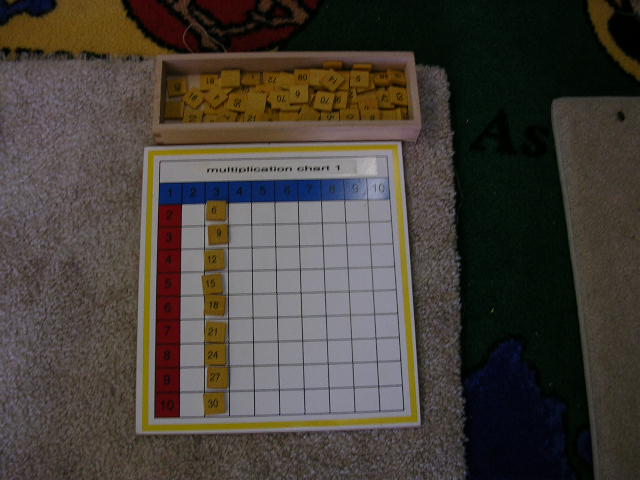
|
| one way to practice the 3 table |
| 3 Cubing Chain |
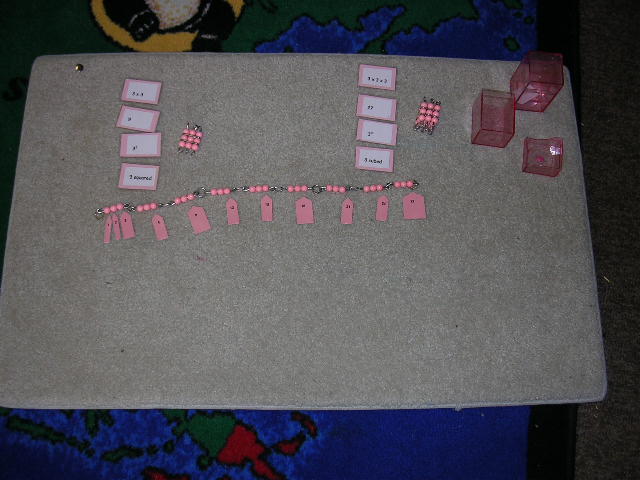
|
| another way to practice the 3 table |
Montessorians believe in Observing the child. This is when we just watch the child work, making notes, either mental or on paper, as to what the child knows and how they process or don't process information. We then use this information to help direct the child's learning. Maybe a child has heard somewhere that a certain concept is hard and they are afraid to attempt it. Then we believe it is important to identify an area where they are competent. We then have them work in that area until they have enough confidence to move on. Slowly, isolating one new concept at a time we move them to what the district calls a benchmark.(Times during the year that the district states that a child in a certain grade needs to know a certain concept.) Although this may seem long and tedious they often catch up to the district's benchmarks and master the standards by the end of the year because they have a firm foundation in the concepts they are learning.
Maybe the child is just so interested in watching a spider crawl across their desk that they don't want to be bothered by what they perceive as the "mundane" and "useless" activity of putting sounds together to make words. There are so many reasons for a child's seemingly lack of desire to learn, but instead of just forcing them to do something they don't want to do, we work with their interests to teach the standards. "Let's measure how far the spider crawls in one minute." (Time and measure are part of every elementary grade standard in California). "Wow! That's cool! Do all spiders crawl that fast, or is this a special one? Where would we find that answer?" (Knowing which research material to use is also an elementary standard.) "What does it say? Well, let me help you learn to read this..."
Montessorians also believe that it is important that children have "personal liberty" or "choice" when it comes to their education. This, by far, doesn't mean that the has freedom to color all day, or choose not to do math, but it does mean that we work with the child to cover the standards in ways that are the most meaningful to them. As in the photos above, we have many ways to teach a concept. In general, do I care if the child uses the 3 chain or the multiplication board, or the many other multiplication materials available to him in the classroom to learn the three tables? Unless a child is abusing a material, or obviously not getting anthing out of it for some reason, they have a choice as to what they use. This "choice" then empowers them to take responcibility for their own education.
Lastly, Montessorians believe that by using the child's own inner strengths and interests, and then integrating them across the curriculum , we promote not only the state mandated standards, but help the child understand why they are so important, and give them the tools and the desire to learn them.
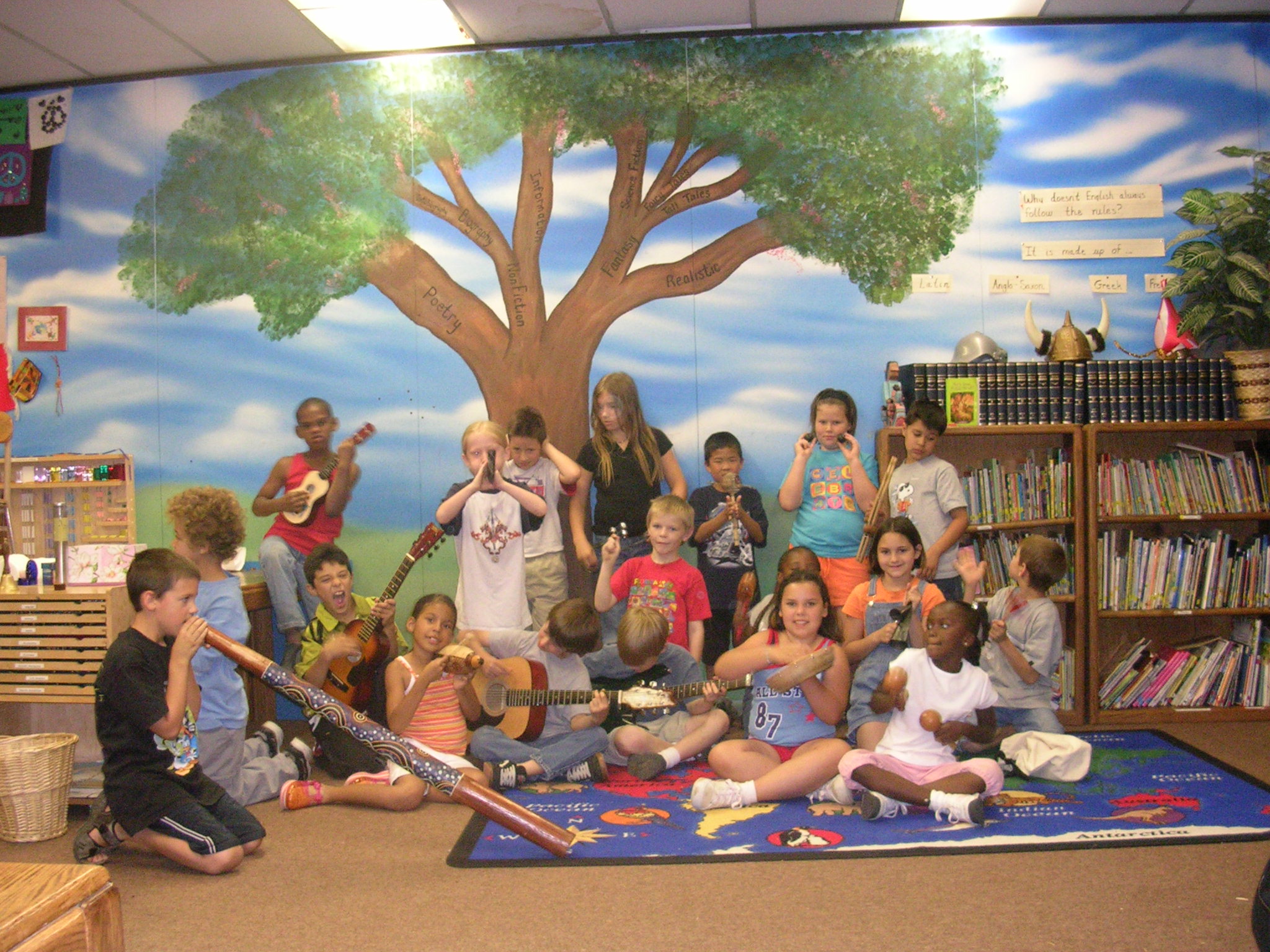
|
| Children playing instruments from around the world. |
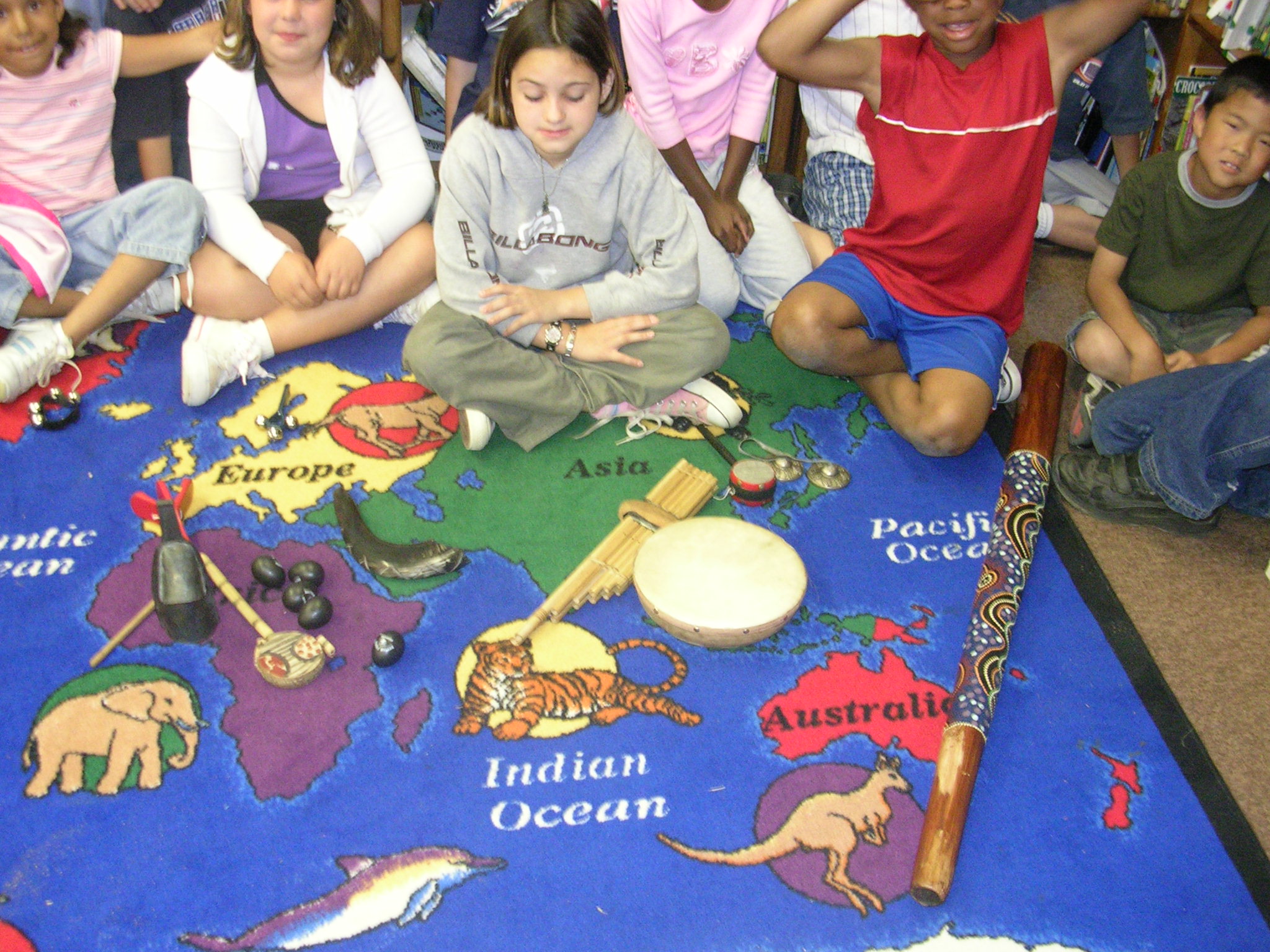
|
| Children have placed the instruments on their country of origin |
|

